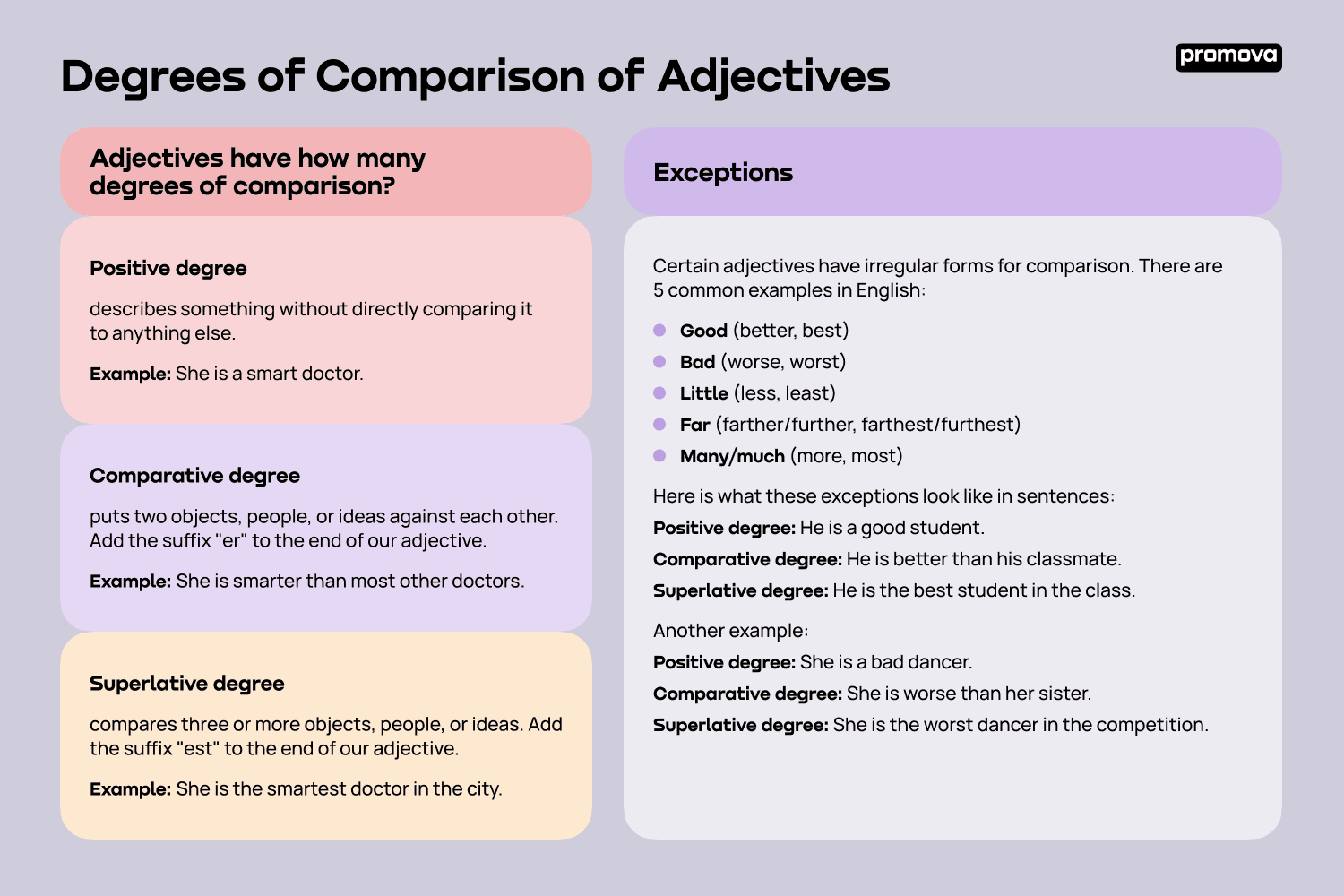Degrees of Comparison of Adjectives
Contents
Comparison of adjectives is an important part of the English language. It helps put two or more things next to each other and express their relative degree. We use it to describe the differences between two objects, people, or ideas.
The three degrees of comparison of adjectives are: positive, comparative, and superlative. This reference will discuss each of these degrees in detail and provide examples of how to use them in sentences. It will also discuss some common mistakes that people make when using comparisons of adjective.
Adjectives have how many degrees of comparison?
Positive, comparative, and superlative are the three degrees of comparison. Each degree is used to describe a different level of intensity or difference between two or more things.
The positive degree of comparison describes something without directly comparing it to anything else. It is used to describe a single object or person. For example, if someone is describing a person as "tall," they are using this form. It's the default form of any adjective.
The comparative degree puts two objects, people, or ideas against each other. It is used to describe the differences between the two things. For example, if someone is describing a person as "taller than the other person," they are using this form.
To create a comparative adjective, we add the suffix "er" to the end of our adjective. For example, in the above example "taller", we are using this form. Other examples include "happier", "stronger", and "prettier".
The superlative degree compares three or more objects, people, or ideas. It is used to describe the highest level of intensity or difference between the three things being compared. For example, if someone is describing a person as "the tallest of the group," they are using the superlative degree of comparison.
To create a superlative adjective, we add the suffix "est" to the end of our adjective. For example, in the above example "tallest", we are using this form. Other examples include "happiest", "strongest", and "prettiest".
Comparison of adjectives examples
When it comes to using comparisons of adjectives in sentences, there are a few key points to keep in mind. First, the degree of comparison must match the number of objects or people being compared. Second, the adjectives being compared must be in the same form. Third, the adjectives being compared must agree in gender and number.
To illustrate these points, here are some examples of comparison of adjectives used in sentences:
- Positive degree: She is a smart doctor.
- Comparative degree: She is smarter than most other doctors.
- Superlative degree: She is the smartest doctor in the city.
Here is another simple example:
- Positive degree: The house is big.
- Comparative degree: The house is bigger than the other one.
- Superlative degree: The house is the biggest of the three.
7
Exceptions
Certain adjectives have irregular forms for comparison. There are 5 common examples in English:
- Good (better, best)
- Bad (worse, worst)
- Little (less, least)
- Far (farther/further, farthest/furthest)
- Many/much (more, most)
Here is what these exceptions look like in sentences:
- Positive degree: He is a good student.
- Comparative degree: He is better than his classmate.
- Superlative degree: He is the best student in the class.
Another example:
- Positive degree: She is a bad dancer.
- Comparative degree: She is worse than her sister.
- Superlative degree: She is the worst dancer in the competition.
Using Comparison of Adjectives in Sentences
When using a comparison of adjectives in sentences, it is important to remember the rules of agreement. The adjectives being compared must agree in gender and number.
For example, if the noun being compared is plural, the adjective must also be plural. If the noun being compared is feminine, the adjective must also be feminine.
Here are some examples of sentences:
- Positive degree: The dogs are friendly.
- Comparative degree: The dogs are friendlier than the cats.
- Superlative degree: The dogs are the friendliest of all the animals.
Remember that the degree of comparison must match the number of objects or people being compared. If two objects are being compared, the comparative degree should be used. If three or more objects are being compared, the superlative degree should be used.
Common Mistakes
One of the most common mistakes is using the wrong degree of comparison. It is important to remember that the degree of comparison must match the number of objects or people being compared.
For example, using the superlative degree of comparison when comparing two objects is incorrect. You can't say "The dogs are the friendliest of the cats". Instead, you should use the comparative degree and say "The dogs are friendlier than the cats".
Another common mistake is using adjectives that don't agree in gender and number. If the noun being compared is plural, the adjective must also be plural. You can't say "The dogs are friendlier than the cat" when talking about more than one specific cat. Instead, you should say "The dogs are friendlier than the cats".

Summary
Comparison adjectives help make our language more detailed. Positive, comparative, and superlative forms help us express this detail. Each degree is used to describe a different level of intensity or difference between two or more things.
When using comparison of adjectives in sentences, it is important to remember the rules of agreement. The adjectives being compared must agree in gender and number, and the degree of comparison must match the number of objects or people being compared.
Hopefully, this reference helps you communicate better in English! Check out more handy articles about grammar below:
Comments